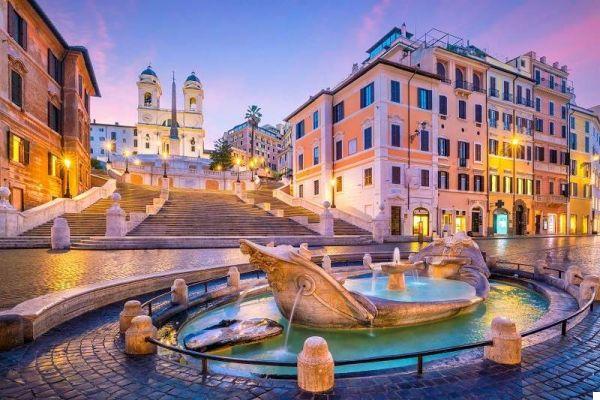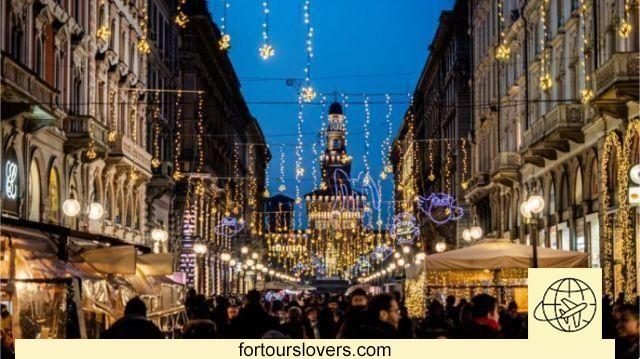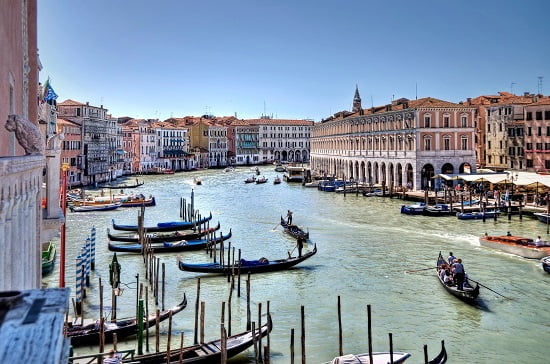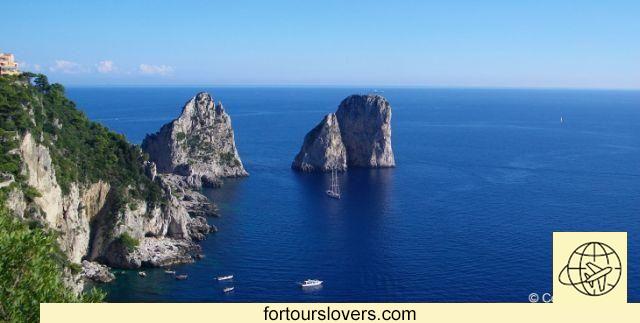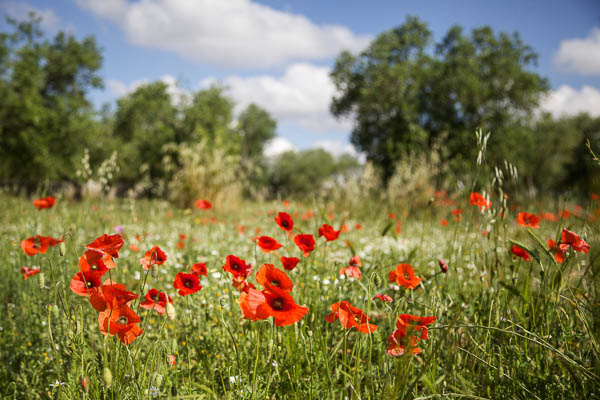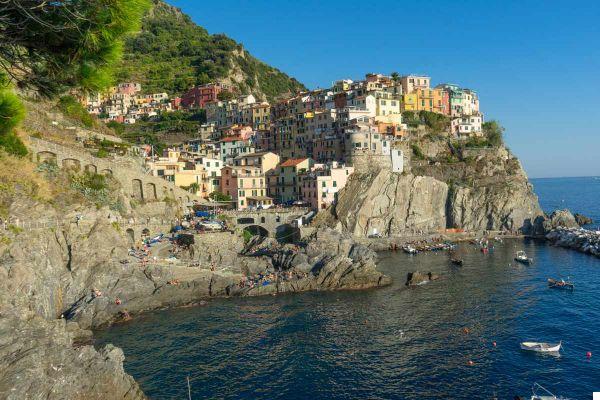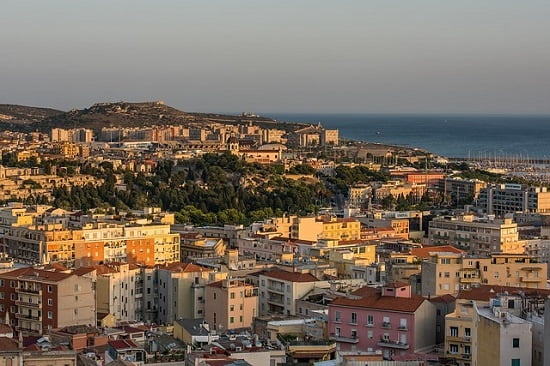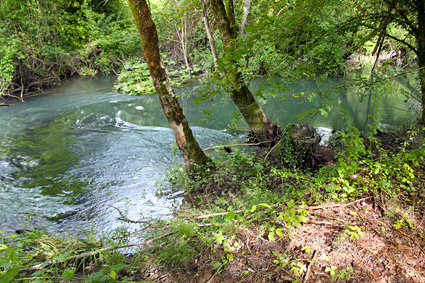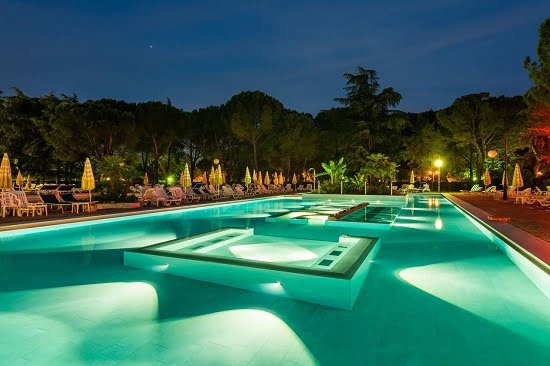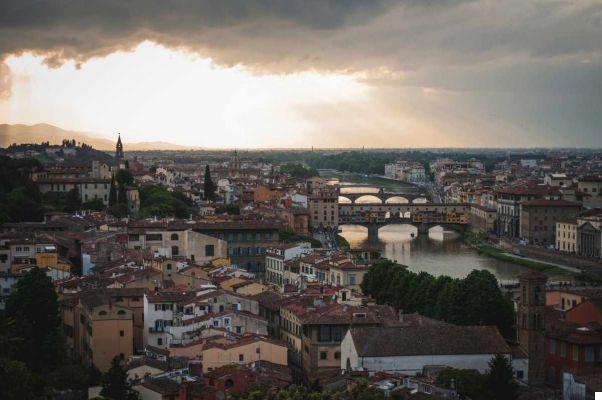If you are planning a trip to Florence, you can't help but visit the masterpieces kept by the Uffizi Gallery.
Although I am not a person who can be defined as an art expert, the Uffizi Gallery is one of the most important museums in Italy and in the world, so I, like everyone else, felt I had to visit it.
Whether you are a Florence for a day or a week, you simply have to visit the Uffizi Gallery.
In fact, inside it houses the largest collections of works by Raphael and Botticelli and the main nuclei of Giotto's work (which I love: for Assisi I admired his paintings for hours in the Basilica of San Francesco, getting excited in front of each of them), Titian, Pontormo, Bronzino, Andrea del Sarto, Caravaggio, Dürer, Rubens and Leonardo da Vinci.
The downside (if it can be considered a disadvantage) is that the Uffizi gallery is huge and a tour could be physically exhausting.
A full day would not be enough to carefully visit all the rooms of the museum and you will probably have only a few hours at your disposal.
So if you are planning a visit, I thought I'd write a short guide on what to see at the Uffizi so that even before leaving you have an idea of the unique things in the world that you are about to "meet"
In this post I recommend the most beautiful works, but also the most interesting rooms of the museum.
CAUTION!
- Uffizi they are reopened from Tuesday to Sunday, from 8.15 to 18.50
From Official site it is specified that:
Given the current emergency with the possibility of contagion, a maximum number of people will be able to access the museums allowing for a minimum distance of one meter from each other (one meter and eighty recommended).
Once the staff in charge of controlling the exhibition halls have reached the maximum number of people allowed, it will prevent access to other people, and will let people waiting in, spaced from each other also by at least one meter.
It is also specified that:
According to LAW DECREE of 22.04.2021, n. 52., for access on the days of Saturdays and holidays reservation will be required to be carried out with at least one day in advance
You must then buy your tickets online and in advance: find them below by clicking on the red buttons:
TICKETS:
UFFIZI TICKET
ACADEMY + UFFIZI
GUIDED TOUR:
GUIDED TOUR
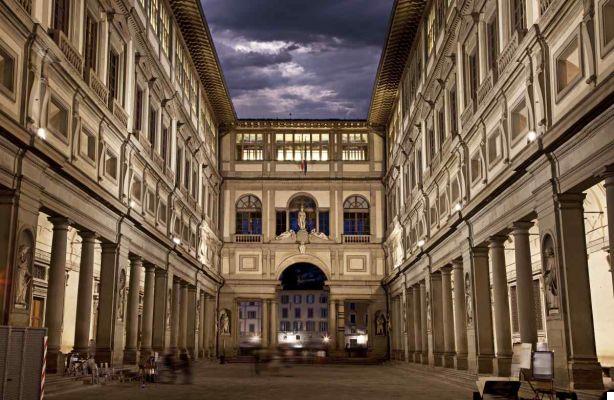
We start by most beautiful works to see in the Uffizi: here are the ones I recommend you include in your museum visit itinerary.
- 1 - Botticelli's Spring
- 2 - The Birth of Venus by Botticelli
- 3 - Michelangelo's Tondo Doni
- 4 - The Adoration of the Magi by Leonardo da Vinci
- 5 - Giotto's Madonna di Ognissanti
- 6 - The Madonna of the Goldfinch by Raphael
- 7 - The Baptism of Christ by Andrea del Verrocchio
- 8 - The Madonna Rucellai by Duccio
- 9 - Titian's Venus of Urbino
- 10 - The Adolescent Bacchus by Caravaggio
- 11 - The Medusa by Caravaggio
- 12 - The Battle of San Romano by Paolo Uccello
- 13 - The most beautiful rooms of the Uffizi
1 - Botticelli's Spring
The famous Spring by Botticelli it is one of the most important works of the Renaissance.
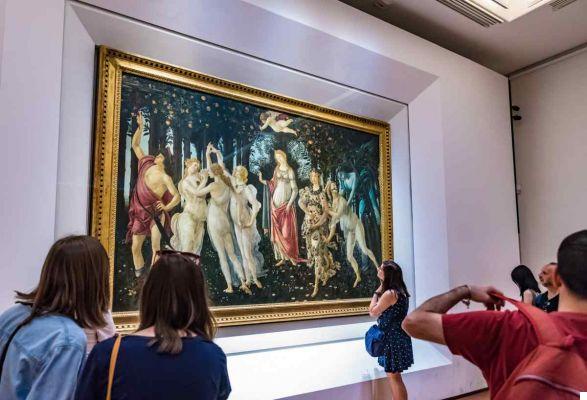
This picture was painted for Lorenzo di Pierfrancesco dei Medici between 1477 and 1482.
Its interpretation is decidedly complex and still uncertain today: the allegorical meanings are numerous and not easy to grasp.
Perhaps this aura of mystery that still surrounds the painting today is one of the reasons for its success.
Regardless of the numerous possible interpretations, what seems to be certain is the role of Venus, the central figure. This, in fact, is identified with Humanitas, the ideal of a humanity that is positive and sensitive to the needs of others, and in the painting it stands as a separation between material loves and spiritual values.
It could be a praise to the Medici and their profound attention to culture and art.
2 - The Birth of Venus by Botticelli
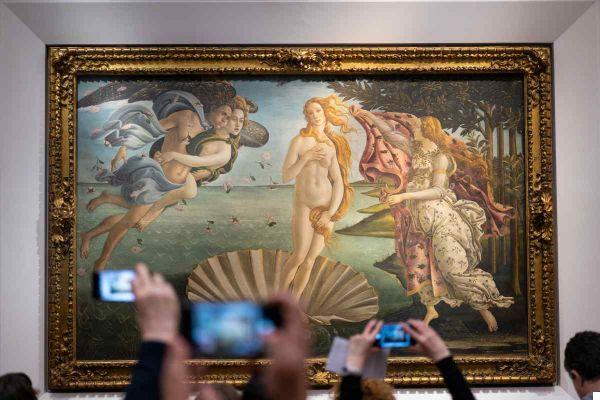
By Hunter Bliss Images on
Also by Botticelli, also La Birth of Venus it is one of the works to see in the Uffizi.
The canvas was painted between 1482 and 1485 and its theme is taken from Ovid's Metamorphoses.
Venus is supported by a shell on the surface of the sea while the winds blow, a delicate rain of roses touches her and a handmaid is ready with a cloth to cover her.
The allegorical meaning of the work could be found in the birth of Love as a force capable of moving life.
3 - Michelangelo's Tondo Doni
An unmissable masterpiece: the Round Gifts it is probably Michelangelo's most spectacular work.
This is the only painting by the artist present in the city of Florence: one more reason not to lose it during the visit.
The work was commissioned by Agnolo Doni, a wealthy banker, and is datable to 1504.
The subject is the Holy Family.
This work is considered the progenitor of Mannerism, a pictorial current in contrast with the balanced shapes and colors that characterized the art of the fifteenth century.
4 - The Adoration of the Magi by Leonardo da Vinci
It is an unfinished work on which Leonardo worked for a long time.
The oil painting on panel was commissioned in 1481 by the monks of San Donato a Scopeto and the Tuscan artist should have finished it within two years.
The genius was then called to Milan by Federico il Moro and left the work unfinished.
What will amaze you more than anything else is its size: we are talking about almost two and a half meters in width and height.
5 - Giotto's Madonna di Ognissanti
This Altarpiece by Giotto it dates back to the years around 1310 and represents a clear example of the artist's desire to overcome the canons of Byzantine painting.
Giotto, in fact, recovered three-dimensional space and concentrated on real space.
It is a work definitely ahead of its time.
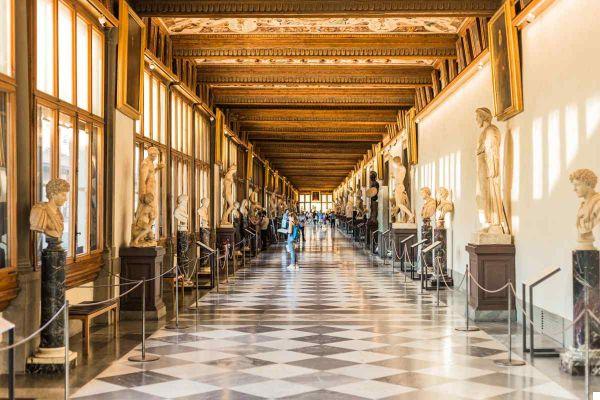
By Cristina Jurca on
6 - The Madonna of the Goldfinch by Raphael
This work was painted by Raphael in the same period in which Michelangelo dedicated himself to the Tondo Doni.
It is a youthful work of the artist that already has some mature characteristics: the study of Leonardo's work comes out strong and clear.
Just think that this painting was destroyed in numerous pieces in 1547 when the house of the Nasi, the client, collapsed.
The work found under the rubble underwent restoration and became part of the collection of Giovan Carlo de 'Medici in 1666.
Another restoration ended in 2008 after 10 years and today Raphael's painting can be admired in all its original beauty.
7 - The Baptism of Christ by Andrea del Verrocchio
This tempera oil on panel is attributed to Verrocchio together with Leonardo da Vinci and other painters of the workshop.
The work can be dated between 1475 and 1478 and was built for the Monastery of San Salvi.
The Baptism of Christ is represented in an original way: it is a triangular composition that starts from the bowl held in the hand of the Baptist and touches the feet of the Saint and the Angel. At the center is the figure of Christ.
8 - The Madonna Rucellai by Duccio
Also known as the Madonna dei Laudesi, the Madonna Rucellai it was painted by Duccio di Buoninsegna around 1285 and was commissioned for the Church of Santa Maria Novella.
In 1591 it was moved to the Rucellai Chapel (from which it takes its name) and only in 1948 did it reach the Uffizi rooms.
It is the largest panel of its kind dating back to the thirteenth century.
Its peculiarity also lies in the depiction of the Madonna, enigmatic and almost smiling, very different from the austere canons of the time.
9 - Titian's Venus of Urbino
Painted in 1538, the Venus of Urbino represents the idea of Venus by Titian, light years away from the one depicted centuries earlier by Botticelli.
At the center of the scene is a completely naked woman who looks the viewer straight in the eye. The scenario is not the classic one taken from the myth, but it is a contemporary domestic setting at the time of the artist.
There are several hidden meanings in this work commissioned by Duke of Urbino Guidobaldo II Della Rovere, but it is probably an allegory of marriage and served to remind the duke's wife of the woman's duties towards her husband.
10 - The Adolescent Bacchus by Caravaggio
Caravaggio painted the Bacchus as a teenager between 1596 and 1598 on commission of Francesco Maria Bourbon del Monte.
It is a work in which realism enters with a straight leg. The artist, in fact, puts aside the mythological element and in the features of the young man we can clearly read his belonging to the people: he could be any person met in a tavern.
The real is always fundamental for Caravaggio and once again there is no landscape behind the protagonist: the attention is focused only on the human traits of the protagonist of the canvas.
11 - The Medusa by Caravaggio
Also the Jellyfish, painted by Caravaggio around 1597, it strikes the attention of those who look at the picture and almost leaves them in stone, a bit like the mythological monster did.
Medusa is portrayed at the exact moment in which her head is cut off: a terrifying scream disfigures her face and blood gushes everywhere.
It is a somewhat macabre work, but with a strong impact.
The paintings of Federico da Montefeltro and Battista Sforza by Piero della Francesca
This famous double can be dated between 1465 and 1472 and is one of the most famous symbols of the Italian Renaissance.
If today the paintings are separate, you need to know that they were once united by a single frame.
The work depicts the spouses Federico da Montefeltro and Battista Sforza, dukes of Urbino.
The two are depicted motionless and in profile, in a static and solemn pose that serves to enhance the moral superiority of the protagonists.
12 - The Battle of San Romano by Paolo Uccello
Finally, among the things to see at the Uffizi there is the Battle of San Romano, a triptych dating back to 1438 representing the historic battles faced by the Florentines.
At the Uffizi there is Bernardino della Carda's Unsaddling: the other two paintings are in London and Paris.
13 - The most beautiful rooms of the Uffizi
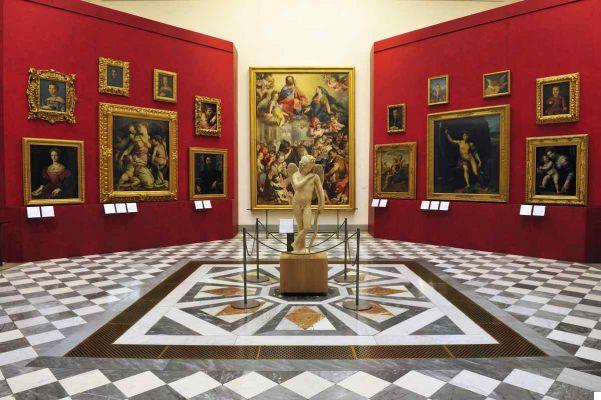
Of T photography on
I continue with the suggestions on what to see at the Uffizi, recommending what, in my opinion, are the most beautiful and interesting rooms in the museum.
Room 1: Archeology and Graphic Arts
If you love archeology, then the first room of the museum is the one you must not miss.
Inside you will find finds mostly belonging to the Roman world such as funerary altars, marbles and sculptures.
Do not miss the "Frieze of the Athena Nike" and the sarcophagus on which the labors of Hercules are represented.
Room 2: from the thirteenth century to Giotto
In this room you will find paintings dating almost entirely to the thirteenth century.
Among the most famous artists there are Cimabue, Duccio's Buoninsegna and obviously, Giotto.
The arrangement of the works almost seems to want to create a comparison between the three artists.
Here you can observe the Madonna Rucellai by Duccio, the Madonna di Santa Trinità by Cimabue and the Madonna di Ognissanti by Giotto.
Through these paintings you will be able to trace the evolution of Italian art in that century.
Rooms 5/6: the International Gothic
In this room you can admire some works of that pictorial language also known as Courteous or flamboyant Gothic.
It is an artistic movement that developed between the end of the fourteenth century and the early fifteenth century and concretely reflects the taste of the courts of the time.
Among the works not to be missed is the Adoration of the Magi by Gentile da Fabriano.
Room 7: the Early Renaissance
After a few years in which the room had hosted an exhibition of works by Gentile da Fabriano, today they are exhibited here again some of the most interesting works of the Renaissance.
Three-dimensionality, light and the centrality of man are the leitmotifs of all the paintings present here.
Do not miss the Battle of San Romano by Paolo Uccello and the Madonna and Child with Sant'Anna by Masaccio and Masolino.
Room 8: Filippo Lippi
This room is entirely dedicated to Filippo Lippi, one of the protagonists of early Renaissance art.
Among the most beautiful paintings is the Madonna and Child with two angels.
In the room you can also admire the double with the portraits of the Dukes of Urbino by Piero della Francesca.
Room 10/14: Botticelli
Two other rooms to see in the Uffizi are absolutely those dedicated to Botticelli.
È here you can admire the Birth of Venus and Spring.
Also dwell on the Portinari Triptych by Hugo van der Goes, a Flemish artist who had considerable influence on the Florentine artists of the time.
Room 15: Leonardo
One of the most famous (and crowded) rooms to see in the Uffizi is that dedicated to Leonardo da Vinci.
Some of the artist's early works are exhibited here.
You will be able to admire The Baptism of Christ painted in Verrocchio's workshop and incomplete Adoration of the Magi.
I advise you to observe carefully too the Annunciation in which natural details demonstrate Leonardo's interest in the real world and science.
Sala 35: Michelangelo ei Fiorentini
Here you will find the paintings of the greatest artists of the sixteenth century.
This is the seat of the Tondo Doni by Michelangelo and numerous works of Tintoretto, of Veronese and Raffaello.
Surely your gaze will also be captured by the sculpture in the center of the room: it is theSleeping Ariadne and dates back to Roman times.
Rooms 57/58: Andrea del Sarto
Here you can admire the works of the Florentine artist Andrea del Sarto, an artist who helps to understand the evolution of painting from the Renaissance to Mannerism.
One of the most famous works is the Madonna delle Arpie inspired by the verses of the Apocalypse.
Room 66: Raphael
Among the tips on what to see at the Uffizi I must definitely include the room dedicated to Raphael.
The works kept here are all beautiful and noteworthy, but among all I remember you Madonna of the Goldfinch, the Self-portrait of 1506 (approximately) and the portrait of Leo X with Cardinals Giulio de 'Medici and Luigi de' Rossi.
Room 83: Titian
This room is dedicated to Venetian painting and the work of Titian.
Between all the paintings you will surely be drawn to Venus of Urbino, a real masterpiece of sensuality and beauty.
Also to be observed carefully is Flora, a portrait of a woman representing Fertility.
Room 90: Caravaggio
Finally, a last beautiful room to visit in the Uffizi is the one dedicated to Caravaggio, the cursed genius who totally revolutionized painting in the eighteenth century.
The representation of Bacco young man whose details make him almost alive at times. Do not miss the Sacrifice of Isaac and Jellyfish, works full of pathos and emotion.
Now that you know what to see in the Uffizi, I hope this guide will be useful for you to better organize your visit to what is one of the most important museums in Florence.






